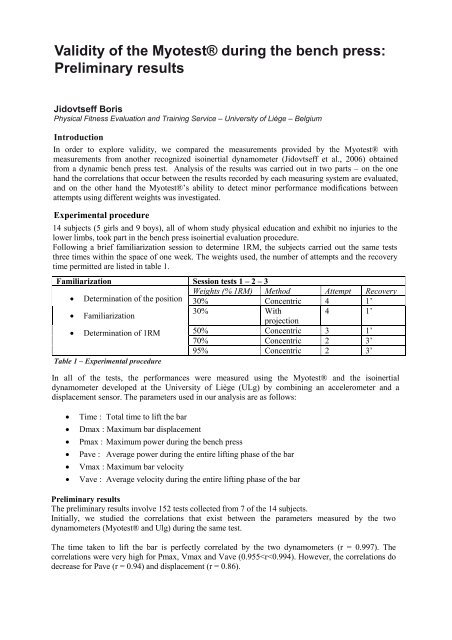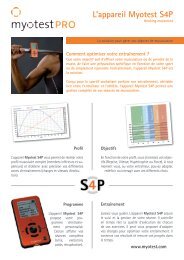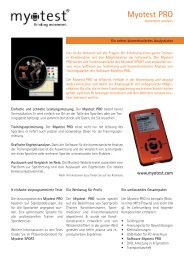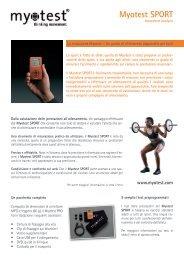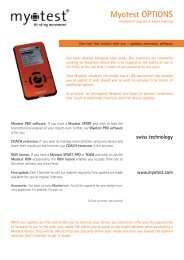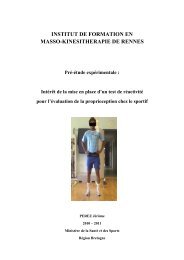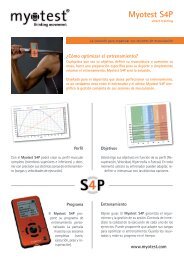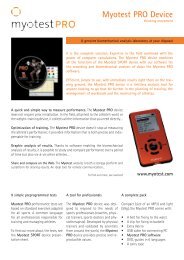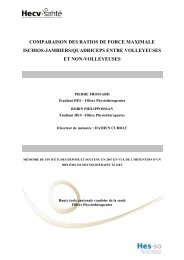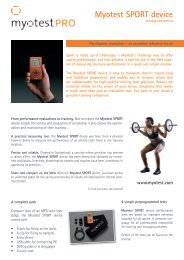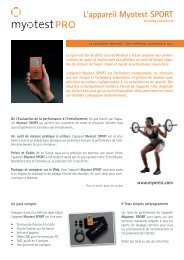Validity of the Myotest® during the bench press
Validity of the Myotest® during the bench press
Validity of the Myotest® during the bench press
You also want an ePaper? Increase the reach of your titles
YUMPU automatically turns print PDFs into web optimized ePapers that Google loves.
<strong>Validity</strong> <strong>of</strong> <strong>the</strong> <strong>Myotest®</strong> <strong>during</strong> <strong>the</strong> <strong>bench</strong> <strong>press</strong>:Preliminary resultsJidovtseff BorisPhysical Fitness Evaluation and Training Service – University <strong>of</strong> Liège – BelgiumIntroductionIn order to explore validity, we compared <strong>the</strong> measurements provided by <strong>the</strong> <strong>Myotest®</strong> withmeasurements from ano<strong>the</strong>r recognized isoinertial dynamometer (Jidovtseff et al., 2006) obtainedfrom a dynamic <strong>bench</strong> <strong>press</strong> test. Analysis <strong>of</strong> <strong>the</strong> results was carried out in two parts – on <strong>the</strong> onehand <strong>the</strong> correlations that occur between <strong>the</strong> results recorded by each measuring system are evaluated,and on <strong>the</strong> o<strong>the</strong>r hand <strong>the</strong> <strong>Myotest®</strong>’s ability to detect minor performance modifications betweenattempts using different weights was investigated.Experimental procedure14 subjects (5 girls and 9 boys), all <strong>of</strong> whom study physical education and exhibit no injuries to <strong>the</strong>lower limbs, took part in <strong>the</strong> <strong>bench</strong> <strong>press</strong> isoinertial evaluation procedure.Following a brief familiarization session to determine 1RM, <strong>the</strong> subjects carried out <strong>the</strong> same teststhree times within <strong>the</strong> space <strong>of</strong> one week. The weights used, <strong>the</strong> number <strong>of</strong> attempts and <strong>the</strong> recoverytime permitted are listed in table 1.Familiarization Session tests 1 – 2 – 3• Determination <strong>of</strong> <strong>the</strong> positionWeights (% 1RM) Method Attempt Recovery30% Concentric 4 1’• Familiarization30% With4 1’projection• Determination <strong>of</strong> 1RM 50% Concentric 3 1’70% Concentric 2 3’95% Concentric 2 3’Table 1 – Experimental procedureIn all <strong>of</strong> <strong>the</strong> tests, <strong>the</strong> performances were measured using <strong>the</strong> <strong>Myotest®</strong> and <strong>the</strong> isoinertialdynamometer developed at <strong>the</strong> University <strong>of</strong> Liège (ULg) by combining an accelerometer and adisplacement sensor. The parameters used in our analysis are as follows:• Time : Total time to lift <strong>the</strong> bar• Dmax : Maximum bar displacement• Pmax : Maximum power <strong>during</strong> <strong>the</strong> <strong>bench</strong> <strong>press</strong>• Pave : Average power <strong>during</strong> <strong>the</strong> entire lifting phase <strong>of</strong> <strong>the</strong> bar• Vmax : Maximum bar velocity• Vave : Average velocity <strong>during</strong> <strong>the</strong> entire lifting phase <strong>of</strong> <strong>the</strong> barPreliminary resultsThe preliminary results involve 152 tests collected from 7 <strong>of</strong> <strong>the</strong> 14 subjects.Initially, we studied <strong>the</strong> correlations that exist between <strong>the</strong> parameters measured by <strong>the</strong> twodynamometers (<strong>Myotest®</strong> and Ulg) <strong>during</strong> <strong>the</strong> same test.The time taken to lift <strong>the</strong> bar is perfectly correlated by <strong>the</strong> two dynamometers (r = 0.997). Thecorrelations were very high for Pmax, Vmax and Vave (0.955
The measurements observed for <strong>the</strong> first three loads (30, 50 and 70% <strong>of</strong> 1RM) appear to be in astraight line. All <strong>of</strong> <strong>the</strong> measurements carried out to 95% demonstrate a linear decline that isdetermined by <strong>the</strong> weights.Myotest3000Time2500200015001000y = 1,1014x - 12,302500R 2 = 0,9934ULg00 500 1000 1500 2000 2500 3000Myotest100908070605040Displacement302010y = 1,6194x - 41,986R 2 = 0,7468ULg00 20 40 60 80 100Myotest1000900800700600500400300200Pmaxy = 1,1285x - 122,01R 2 = 0,9154100ULg00 200 400 600 800 1000MyotestPave400350300250200150100y = 1,3088x - 122,650R 2 = 0,8835ULg00 50 100 150 200 250 300 350 400Myotest3VmaxMyotest1,6Vave2,51,421,211,50,81y = 1,0412x - 0,14610,5R 2 = 0,9882ULg00 0,5 1 1,5 2 2,5 30,60,40,2y = 1,0446x - 0,1482R 2 = 0,9884ULg00 0,2 0,4 0,6 0,8 1 1,2 1,4 1,6Figure 1 – Correlations between <strong>the</strong> measurements observed by <strong>the</strong> two dynamometers for <strong>the</strong> mainparameters.Equally interesting is a comparison <strong>of</strong> <strong>the</strong> measurements <strong>of</strong> each dynamometer when a subject carriesout <strong>the</strong> <strong>bench</strong> <strong>press</strong> test.(m.s -2 )1,6Vave(m.s -2 )3Vmax1,42,51,2120,81,50,60,40,20ULgMytest(%1RM)30 30 30 30 30 30 30 30 50 50 50 70 70 95 9510,50ULgMytest(%1RM)30 30 30 30 30 30 30 30 50 50 50 70 70 95 95
(watts)400Pave(watts)900Pmax350300250200150100500ULgMytest(%1RM)30 30 30 30 30 30 30 30 50 50 50 70 70 95 958007006005004003002001000ULgMytest(%1RM)30 30 30 30 30 30 30 30 50 50 50 70 70 95 95Figure 2 – Performances measured by <strong>the</strong> dynamometers with a subject lifting different weights <strong>during</strong> asingle session.Clear parallels between <strong>the</strong> power (Pave and Pmax) and velocity (Vave and Vmax) measurements canbe observed among <strong>the</strong> results received from <strong>the</strong> two dynamometers.The average values provided by <strong>Myotest®</strong> appear to be slightly lower. At 95% <strong>of</strong> 1RM on <strong>the</strong> o<strong>the</strong>rhand, <strong>the</strong> results provided by <strong>the</strong> two measuring systems prove to be very different.Interpretations and conclusionsThis collection <strong>of</strong> preliminary results shows that <strong>the</strong> <strong>Myotest®</strong> provides valid values <strong>during</strong> <strong>the</strong> firstthree loads (30, 50 and 70% <strong>of</strong> 1RM). The parallel observed by <strong>the</strong> ULg dynamometer alsodemonstrates that it is highly sensitive to minor variations in performance. This sensitivity remains abasic useful quality when trying to track <strong>the</strong> long-term effects and results <strong>of</strong> training. However, at 95%<strong>of</strong> 1Rm, <strong>the</strong> <strong>Myotest®</strong> appears to have reached <strong>the</strong> limits <strong>of</strong> its validity: The results no longer entirelymatch those obtained with <strong>the</strong> ULg dynamometer.At this load, it is probably <strong>the</strong> case that <strong>the</strong> movement,being very slow and very long, is plaguedby a parasitic signal that favors an accumulation<strong>of</strong> errors, and thus has a direct chain-reactioneffect on <strong>the</strong> velocity and power measurements.The error could stem from <strong>the</strong> procedure used tocalculate <strong>the</strong> two scales. We were in fact able tocorrect most <strong>of</strong> <strong>the</strong> data drift by going back to <strong>the</strong>accelerometer’s original signal. Within <strong>the</strong> scope<strong>of</strong> this type <strong>of</strong> procedure, this observation leadsus to believe that an improvement in <strong>the</strong> dataanalysis process would increase <strong>the</strong> validity <strong>of</strong><strong>the</strong> <strong>Myotest®</strong> measurements across all loads.(m.s -2 )VmaxReferenceJidovtseff et al. – The concept <strong>of</strong> iso-inertial assessment: Reproducibility analysis anddescriptive data. Isokinetics Exerc Sci, 14, 53-62, 2006.32,521,510,50ULgMytestMyo-Corr(%1RM)30 30 30 30 30 30 30 30 50 50 50 70 70 95 95Figure 3 – The yellow curve represents <strong>the</strong> Vmaxrecalculated for each load based on <strong>the</strong> gross accelerationdata <strong>of</strong> <strong>the</strong> <strong>Myotest®</strong>


